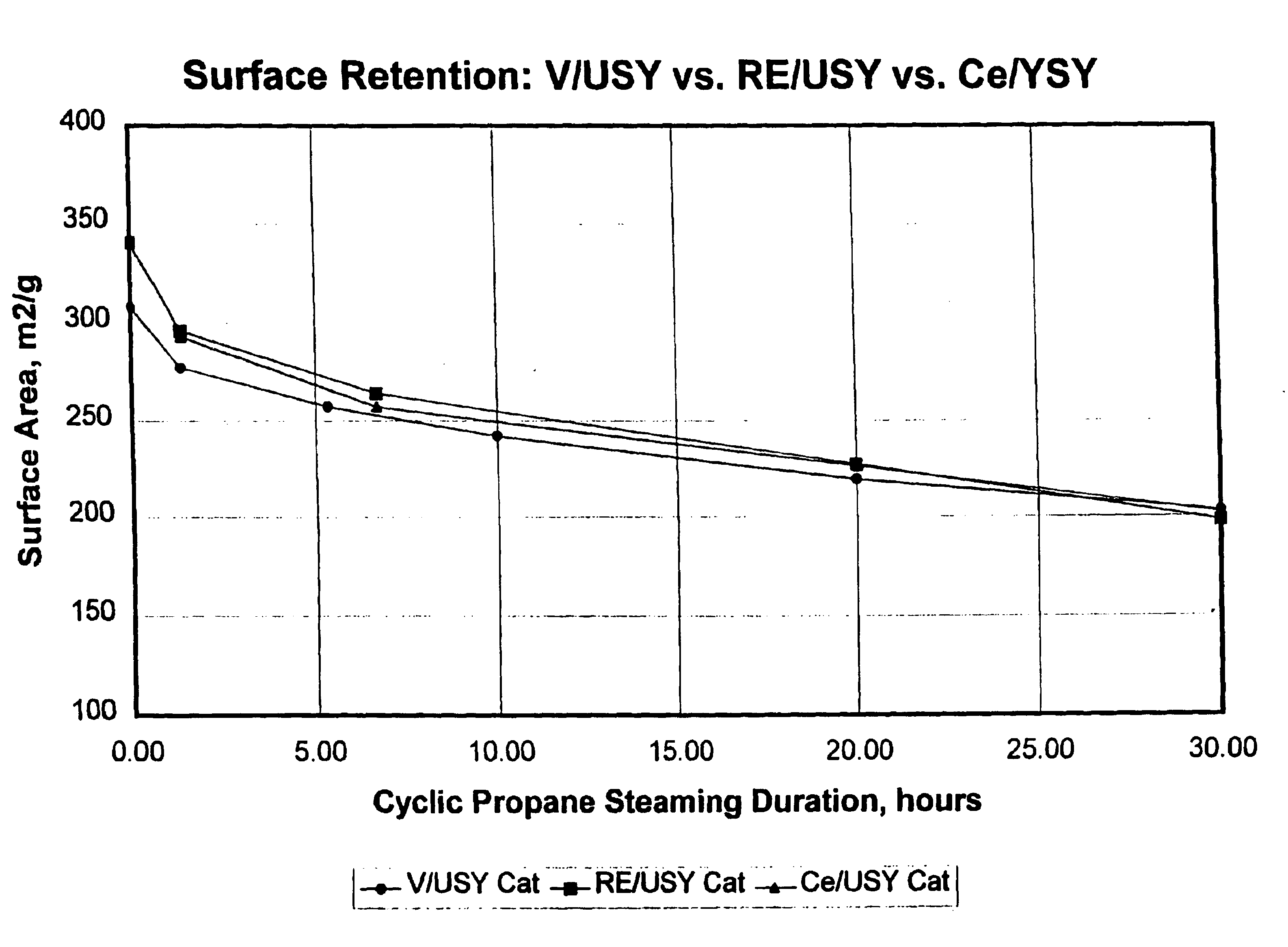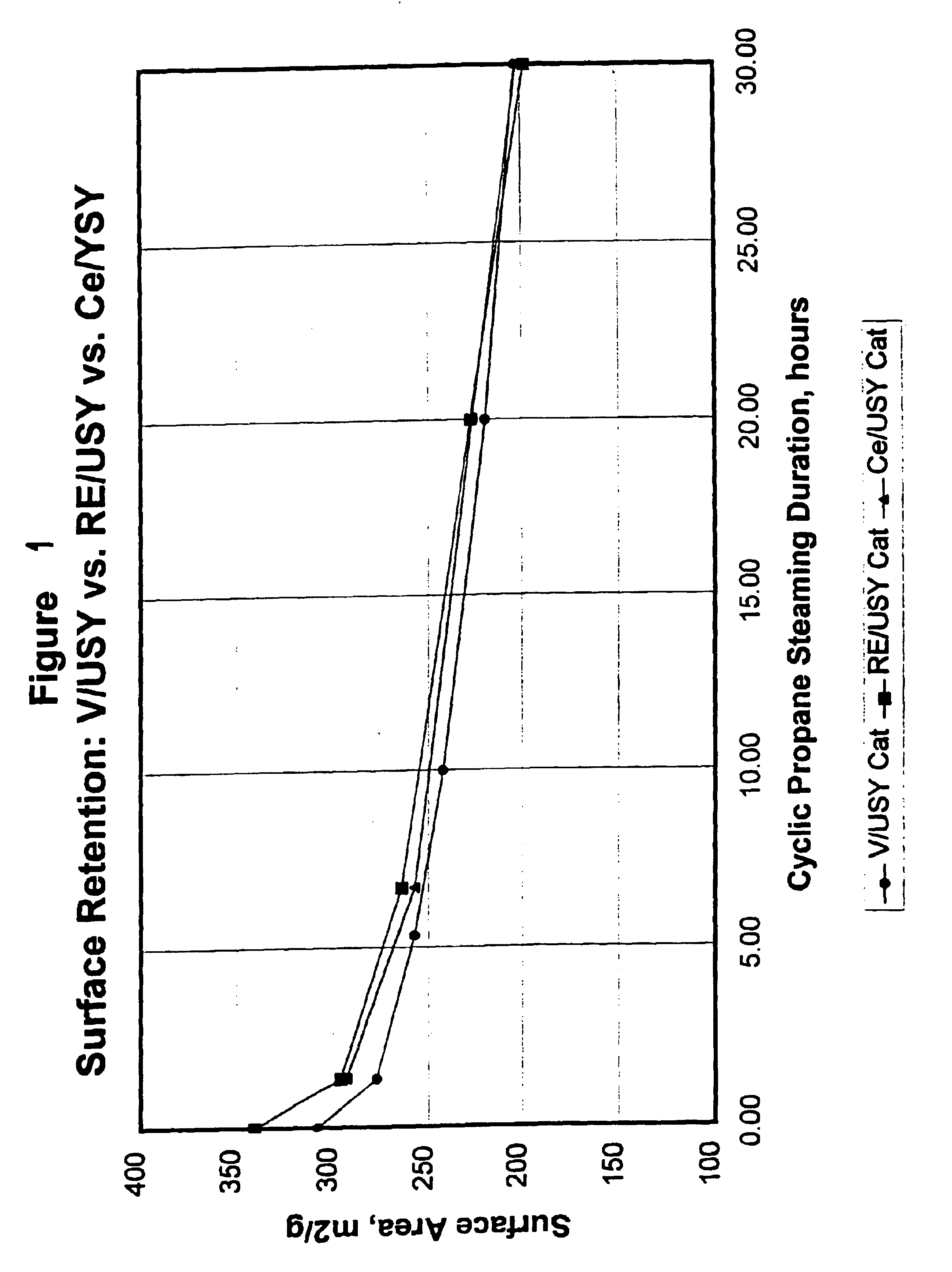Gasoline sulfur reduction in fluid catalytic cracking
a technology of gasoline sulfur and fluid catalytic cracking, which is applied in the direction of catalytic cracking, molecular sieve catalysts, physical/chemical process catalysts, etc., can solve the problems of product sulfur levels not being greatly reduced, valuable product octane may be lost, and the approach is expensive in terms of equipment and operational costs, so as to improve the reduction of sulfur content, enhance the stability of the catalyst, and reduce the effect of sulfur conten
- Summary
- Abstract
- Description
- Claims
- Application Information
AI Technical Summary
Benefits of technology
Problems solved by technology
Method used
Image
Examples
example 1
[0056]Preparation of Catalyst Series 1
[0057]All samples in Catalyst Series 1 were prepared from a single source of spray dried material, consisting of 50% USY, 21% silica sol and 29% clay. The USY had a starting unit cell size of 2.454 nm, SiO2 / Al2O3 mol ratio of 5.46 and a total surface area of 810 m2g1.
[0058]A V / USY catalyst, Catalyst A, was prepared by slurrying the above spray dried catalyst with NH4 OH at a pH of 6, followed by filtration, ammonium sulfate exchange and washing with water. The catalyst was calcined in the presence of steam at 1300° F. for 2 hours and impregnated with vanadyl oxalate. The steam calcination lowered the unit cell size of the zeolite and improved its stability in the presence of vanadium.
[0059]A V / USY catalyst, Catalyst B, was prepared in the same way as Catalyst A, with the exception that the initial slurrying of the catalyst was performed at a pH between 3.2 and 3.5.
[0060]Two RE+V / USY catalysts, Catalyst C and D were prepared in the same way as Ca...
example 2
[0063]Preparation of Catalyst Series 2
[0064]A V / USY catalyst, Catalyst F, was prepared using a USY zeolite with a silica-to-alumina ratio of 5.4 and unit cell size of 2.435 nm. A fluid catalyst was prepared by spray drying an aqueous slurry containing 50 wt % of the USY crystals in a silica sol / clay matrix. The matrix contained 22-wt % silica sol and 28-wt % kaolin clay. The spray-dried catalyst was exchanged with NH4+ by an exchange with a solution of ammonium sulfate and then dried. Then the USY catalyst was impregnated with a solution of vanadium oxalate to target 0.5 wt % V.
[0065]A RE+V / USY catalyst, Catalyst G, was prepared using a USY zeolite with a silica-to-alumina ratio of 5.5 and a unit cell size of 2.454 nm. The USY was exchanged with NH4+ by an exchange with a solution of ammonium sulfate. The NH4+ exchanged USY was then exchanged with rare earth cations (e.g., La3+, Ce3+, etc.) by exchange with a solution of mixed rare earth chlorides. The rare earth solution that was u...
example 3
[0068]Fluid Catalytic Cracking Evaluation of Series 1 Catalysts
[0069]The catalysts from Example 1 were steam deactivated in a fluidized bed steamer at 770° C. (1420° F.) for 20 hours using 50% steam and 50% gas. The gas stream was changed from air, N2, propylene, and to N2 for every ten minutes, then cycled back to air again to simulate the coking / regeneration cycle of a FCC unit (cyclic steaming). The steam deactivation cycle was ended with air-burn (ending-oxidation). Twenty-five weight percent of steamed additive catalysts were blended with an equilibrium catalyst of very low metals level (120 ppm V and 60 ppm Ni) from an FCC unit.
[0070]Performances of the catalysts are summarized in Table 4, where the product selectivity was interpolated to a constant conversion, 65 wt % conversion of feed to 220° C. or below (430° F.-) material.
TABLE 4Catalytic Cracking Performance of Series 1 Catalysts+25%+25%+25%ECat+25%+25%RE +RE +RE +BaseV / USYV / USYV / USYV / USYV / USYCaseCat ACat BCat CCat DCat...
PUM
| Property | Measurement | Unit |
|---|---|---|
| weight percent | aaaaa | aaaaa |
| size | aaaaa | aaaaa |
| particle size | aaaaa | aaaaa |
Abstract
Description
Claims
Application Information
 Login to View More
Login to View More - R&D
- Intellectual Property
- Life Sciences
- Materials
- Tech Scout
- Unparalleled Data Quality
- Higher Quality Content
- 60% Fewer Hallucinations
Browse by: Latest US Patents, China's latest patents, Technical Efficacy Thesaurus, Application Domain, Technology Topic, Popular Technical Reports.
© 2025 PatSnap. All rights reserved.Legal|Privacy policy|Modern Slavery Act Transparency Statement|Sitemap|About US| Contact US: help@patsnap.com



